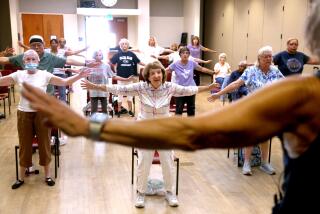Listening for balance
Standing up straight and keeping your body centered may seem like second nature to most of us. But for people with balance disorders, it is anything but easy. Wobbly and unsure on their feet, they often have difficulty walking and are prone to falls, a leading cause of injury and death in the elderly.
Certain diseases and medications, or the normal wear and tear of aging, can weaken the sensory signals transmitted to the part of the brain that governs gravitational stability, which is why people become unsteady, dizzy or disoriented.
Now scientists have developed a novel balance feedback device that weighs less than a pound and can be worn on a belt like a pager. It may help correct balance difficulties by providing sufferers with the sensory data they are missing.
“Balance disorders can be terribly social-stigmatizing because people think they’re drunk, and some people withdraw from daily activities because they’re afraid of falling,” says Christopher Platt, program director for balance and vestibular sciences for the National Institute on Deafness and Other Communication Disorders in Bethesda, Md. “A device that accelerates someone’s ability to retrain themselves holds a lot of promise.”
An estimated 20% of Americans suffer from balance disorders. These difficulties can be triggered by viral infections, head injuries, aging, illnesses such as multiple sclerosis and Parkinson’s disease, or inner ear damage, which can be caused by Meniere’s disease, poor blood circulation or some antibiotics.
Although maintaining balance may seem effortless, keeping your body stable is a gravity-defying skill that requires input from three main senses, says Fay Horak, a neuroscientist who helped develop the new technology at the Oregon Health and Science University in Beaverton. The brain integrates information from our vision, from the vestibular (balance) system in the inner ear and from the somatosensory system -- the sense receptors in our muscles, joints, skin and feet -- that tells us where our body is in reference to surfaces that we contact.
Most people sway slightly when they’re standing still. “You think you are totally frozen, but your body is making little movements that your brain controls to maintain your balance,” says Marco Dozza, a biomedical engineer at the University of Bologna in Italy, who is part of the OHSU research team.
If a person doesn’t receive enough information from the innate balance sensors, especially from the vestibular system that regulates our sense of gravity, he or she can become quite wobbly without realizing it. As a consequence, he may tilt too far and topple over. “It’s basic physics,” says Dozza. “The bigger the sway, the more likely it is to fall.”
The auditory balance feedback device can help rehabilitate a person’s damaged sensory system. The lightweight appliance, which contains sensors, is hooked to a belt and connected to a pair of headphones. The device acts much like a carpenter’s level and emits auditory cues to let users know when their body is swaying too much so they can make corrections. Different tones and intensities tell subjects which way they are leaning: a high-pitched tone, for example, signals that they are leaning forward and grows louder if they bend farther; a lower sound tells them they’re swaying backward.
“People intuitively learn how to use the device in about a minute, and it’s all very natural,” Horak says. “The brain immediately integrates the information with other sensory input.”
Results of a study this year were encouraging. The research involved nine volunteers who suffered from such severe balance problems that they had trouble standing on a piece of foam without losing their balance. While using the feedback device, the participants decreased their sway area by 23%, reduced their body movements by 46% and increased time spent within their safety zone by 195%.
OHSU researchers are now doing follow-up studies to determine how long the effect of the balance training device lasts. “We’d like to use this not just for rehabilitation but as a prosthetic that can help people in their daily lives,” Horak says.
The next step for Horak and her colleagues is to demonstrate that the device can actually help people walk -- a far more complex task than helping people stand up straight.
*
(BEGIN TEXT OF INFOBOX)
Devices on the move
Other tools to improve balance are under development.
Scientists at the University of Wisconsin in Madison have developed the BrainPort,
a sensory substitution device that studies show can deliver missing sensory data through an electronic strip placed on the tongue. The patient wears a helmet embedded with microsensors. When the patient’s head moves, the microsensors send a signal to electrodes on the tongue, creating a light buzzing sensation. The location of the buzz on the tongue tells the brain what position the head is in.
And Boston University researchers are testing a foot vibrator. The noise from the vibration amplifies weak signals and makes the nerves in the feet more sensitive to the pressure changes that occur when the body moves. A 2003 study showed that the device improved balance in a dozen healthy 75-year-olds, whose body sway became comparable to 23-year-olds’ in the study’s control group.
-- Linda Marsa





